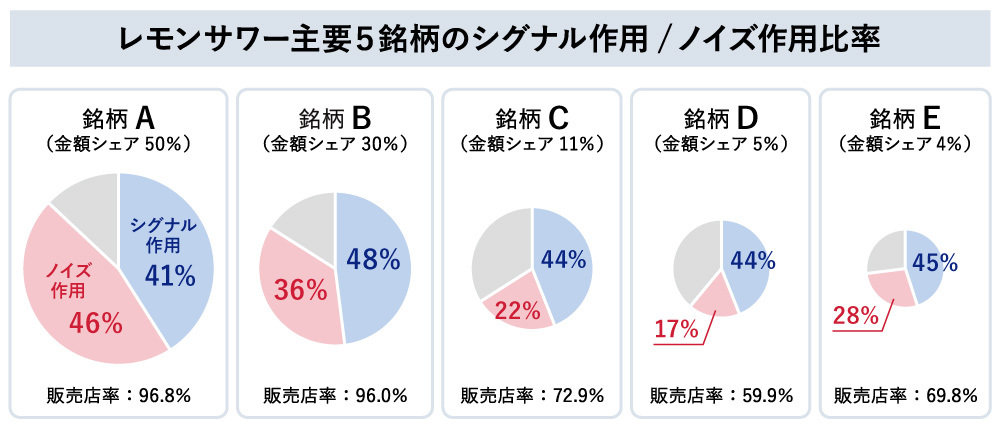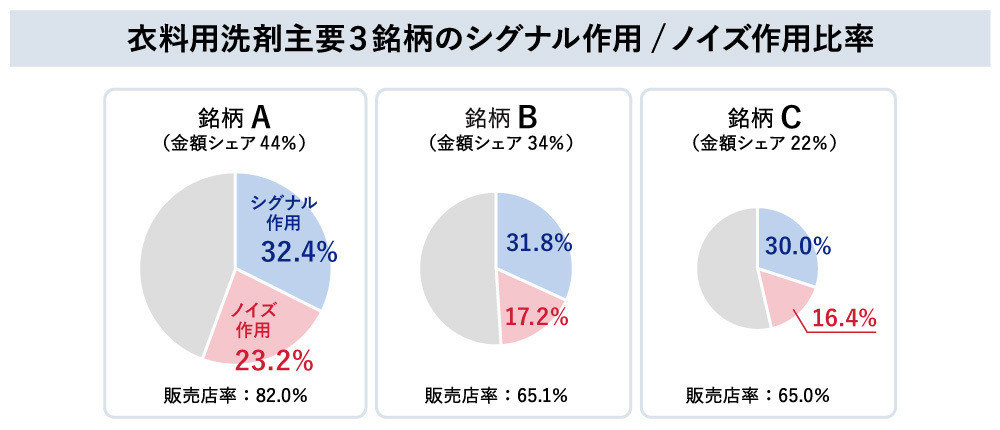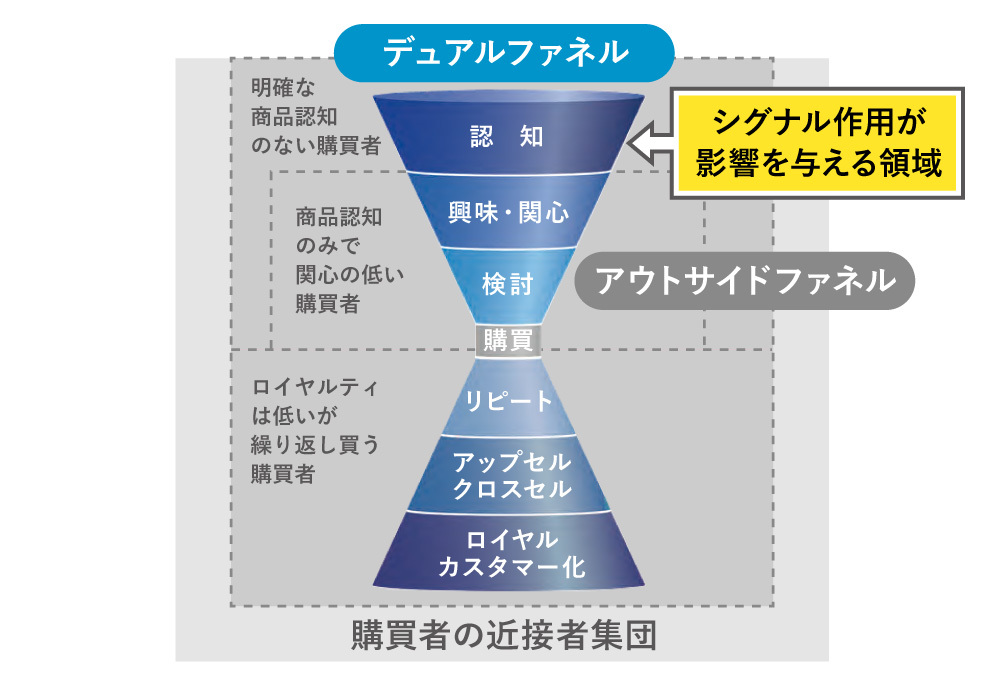The Power of Advertising to Encourage People Who Buy "Just Because"
The cross-departmental "SN Project Team(※)" at Dentsu Inc. has published two articles so far on the new market structure discovered from a behavioral economics perspective: "How do people buy things?"
※ = SN Project Team
This is an internal cross-functional research team comprising experts from Dentsu Inc.'s Marketing Division, Data Solutions Division, and Media Division. "SN" was chosen to reflect the core research findings: the "signaling effect/noise effect of advertising."
The first article introduced how sales of a certain product included many purchases by people not interested in that product category. It explained that the following three points are crucial for the market structure formed by product sales .
- Dual Funnel: The core area of marketing activities that "increases customer interest in the product"
- Outside Funnel: The area containing consumers who purchase but have low interest in the product or category
- Proximal Group: The group that spreads the word through "word-of-mouth" and "conversations," creating opportunities for product purchase and influencing others

In Part 2, we classified the psychological motivations driving purchases among market participants into "three habits" and analyzed how these habits influence purchasing decisions across different product categories.
This time, we explain how "advertising" actually influences purchasing behavior using the concepts of "Signal (S)" and "Noise (N)"—the very concepts that gave rise to the name "SN Project."
<Table of Contents>
▼Advertising's "Signal Effect" Influencing Those Already Interested
▼Advertising's "Noise Effect" Influencing Those Buying "Without Much Thought"
▼Do Best-Selling Products Benefit from Advertising's "Noise Effect"?
▼Advertising Communication That Doesn't Just Target the Main Audience
The "Signaling Effect" of Advertising That Influences Those Already Interested
First, let's explain the "signal effect" of advertising. The signal effect refers to the impact where, upon encountering an ad, the viewer perceives it as "personalized" and develops interest or favor toward the product.
For example, imagine Mr. A, feeling hungry, walking through town and seeing an advertisement for a delicious-looking hamburger. At that moment, Mr. A notices the advertisement and thinks, "That looks delicious. I'd love to eat that..."
The advertising effect that creates a strong impression or psychological change in Person A at this moment is called the "signaling effect."
Signal effect is expected to produce results similar to those achieved by certain types of targeted advertising. Viewed through a funnel perspective, it particularly stimulates those with high interest in the category, thus having the characteristic of stimulating the "dual funnel."
Since it influences groups already showing interest, it is particularly effective for boosting short-term purchase rates.
The "noise effect" of ads that influence people buying "on a whim"
On the other hand, the "noise effect" of advertising refers to ads that, upon initial exposure, are not perceived as "personalized" or relevant to the individual at that moment. In other words, it describes ads that, while recognized, do not influence psychological change.
For example, suppose Mr. B, who is full, sees a hamburger ad while out and about. At that moment, he merely notices the ad without increasing his interest. The effect where the ad leaves only a vague impression without significantly boosting favorability is called the "noise effect" of advertising.
Written this way, the noise effect might seem meaningless, but it actually plays a crucial role in marketing.
When organized within the funnel, this advertising effect—which targets uninterested segments—has the characteristic of stimulating the "outside funnel."
The noise effect influences brand recall during "impulse" purchases, ultimately contributing to sales growth. Since the segment within the outside funnel has low purchase frequency/motivation, stimulating this group through the noise effect is expected to contribute to improving purchase rates over the medium to long term.

Furthermore, as mentioned in the first article, the market contains a large "low-interest segment" that cannot be ignored in marketing. Therefore, focusing on the noise effect is important in terms of influencing this "low-interest segment."
As outlined above, the differences between the signal effect and the noise effect can be summarized as follows.
Do best-selling products benefit from the "noise effect" of advertising?
Advertising effects were divided into two categories using the concepts of signal and noise. While noise effects might seem unlikely to contribute to purchases at first glance, Dentsu Inc.'s proprietary research revealed they play a significant role.
The survey classified purchasers of five major lemon sour brands based on their awareness of commercials and the degree of influence those commercials had, as follows:
① Signal Effect Purchasers:
Purchasers who recognized the commercial and were emotionally moved by the advertisement
② Noise Effect Buyers:
Recognized the commercial but were not emotionally moved by the advertisement
Looking at the ratio of buyers falling into categories ① and ② for each brand with differing sales figures, the result is shown in the figure below.
(Gray represents the segment that purchased the product without recognizing the advertisement)

First, focusing on the segment with signal effect (blue in the figure above), its ratio to sales is significant for every brand, indicating it constitutes an important part of the customer base.
Interestingly, this ratio exists at a nearly constant level for each brand, regardless of the size of their sales.
So, what factors influence the size of sales? It turns out it's the "noise effect."
Focusing on the noise effect layer (red in the figure above), we see that while some brands have relatively large noise effects despite small market shares, the ratio increases as sales grow larger.
This trend is not unique to the lemon sour market; it was also observed in the laundry detergent market.

Although noise effects are often overlooked because they contribute less to short-term sales, popular products tend to be more significantly impacted by them in terms of sales share.
Advertising communication that looks beyond the main target audience
Traditional marketing typically centered strategies around the "main target"—those highly interested or likely to be interested in the company's brand. Of course, this core target group is crucial, accounting for the majority of sales.
However, relying solely on this approach stifles brand growth. The main target isn't the only group buying your products. Many people purchase them "just because." To ensure your products are chosen by these buyers too, it's crucial to maintain continuous advertising communication. This builds awareness so your brand is selected when the buying opportunity arises. Therefore, we believe the influence of the noise effect should be considered within marketing strategy.
This time, we introduced the concepts of signal and noise and conducted an analysis for a specific category. Next time, we plan to move into the "practical application" phase, applying this analysis to our own products and leveraging it in actual marketing efforts.
[Dentsu Inc. Independent Survey Overview]
Survey Period: July 19, 2021 - July 25, 2021
Area: Kanto region (Tokyo and six prefectures)
Sample Size: 4,000 respondents
Note: Surveyed 20 brands across 7 FMCG categories
Was this article helpful?
Newsletter registration is here
We select and publish important news every day
For inquiries about this article
Back Numbers
Author

Asada Taihei
Dentsu Inc.
Since joining the company, I have worked as a media planner handling a wide range of industries including automotive, insurance, and beverages. Focusing primarily on television and digital, I am responsible for integrated planning aimed at maximizing advertising effectiveness for clients. Since 2021, I have been working as a producer in the television buying domain.





